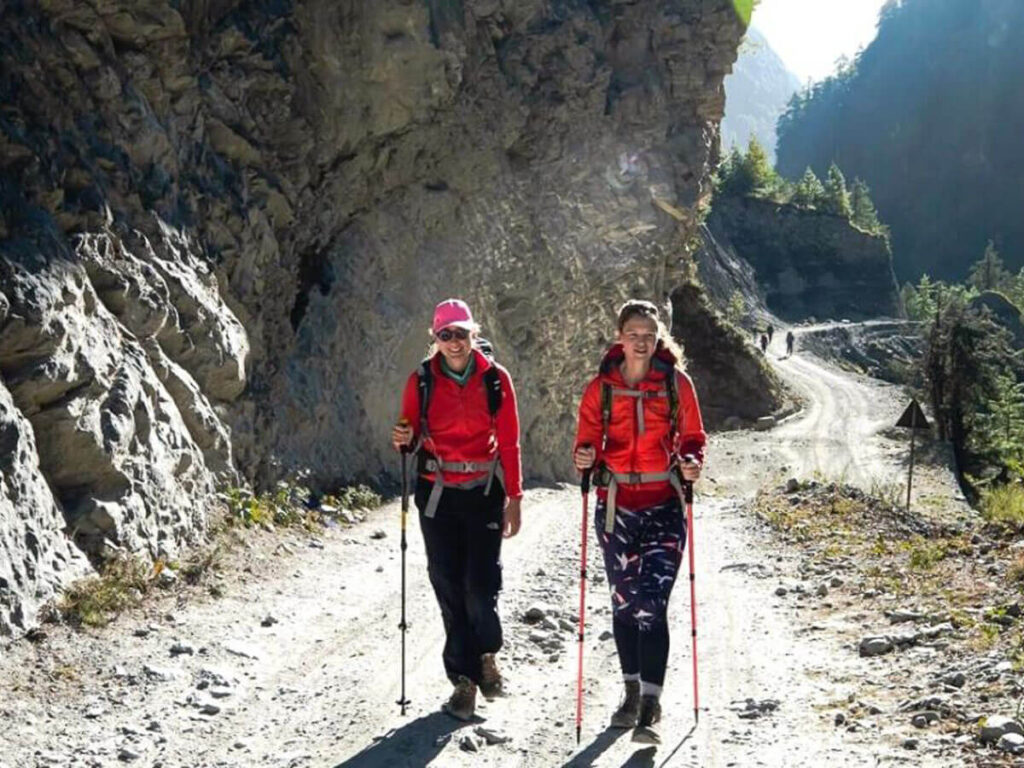
The Best Trekking Routes: Annapurna Base Camp Trekking to Annapurna Base Camp is a dream journey for many trekkers, rich in spectacular views of the Himalayas, lively scenery, and rich culture of Nepal. But for novice trekkers, the adventure can seem overwhelming. With proper preparation, the experience can also be safe and enjoyable. Here are a few important things to know about your first trek to Annapurna Base Camp.
Physical fitness is one of the significant factors in preparing for the Annapurna Base Camp trek. The trek covers varying terrains, ranging from steep ascents to steep descents, so you need to condition your body. Though the trek is rated as moderate, you will be better able to handle the physical challenge if you are in good shape. You will be better prepared for the journey if you do some cardiovascular exercises to build up stamina, as well as exercises that strengthen your legs and core, and hike with a loaded backpack.
What another crucial element of the preparation. Annapurna Base Camp is at 4,130 meters (13,550 feet), and altitude sickness is a genuine threat. The secret to avoiding altitude sickness is excellent acclimatization. Trek at a slow, steady pace, allowing your body time to acclimatize to the thinner air, particularly as you gain elevation. Rest days at critical junctions along the trek, including Chhomrong or Bamboo, will allow your sensitive body to acclimatize and lower your ultimate risk of altitude-related health complications.
Choosing the right gear is essential for comfort and safety on the trek. Purchase solid trekking boots, a warm sleeping bag, layered clothing for both the cold and warm and a waterproof jacket. A good daypack will enable you to haul around your essentials such as water, snacks, and spare layers. If you’re planning on tackling any of the downhill sections, don’t forget to pack a good pair of trekking poles to help ease the strain on your knees. Trekking at high altitudes will take a toll on your body so you need to pack wisely and not have to carry everything you think you need.
Annapurna trek is quite different from many other treks with its cultural diversity. You will get to interact with the local Gurung and Magar communities while passing through the villages of Ghorepani, Tadapani, and Chhomrong. A lot of the people who inhabit these villages earn a living in the tourism industry, and they are used to dealing with trekkers. If playing with local children in the villages, however, learning some basic phrases in Nepali (like “Namaste,” hello and “Dhanyabad,” thank you) can never hurt and often adds to the experience.
In the mountains, the weather can change in an instant, so you must prepare well. Spring and autumn weather is typically mild, but the temperature may plummet in the early hours of the morning and late at night. In higher altitudes, even during summer months, temperatures can plummet below freezing, so make sure you bring warmer clothing such as a jacket, hat, and gloves. There’s not a single person who ever climbed a mountain thirsty! The water supply in the places you will want to go will not always be guaranteed to be potable — it’s a good idea to invest in a water filter or carry purification tablets.
The last important point is to manage your expectations when trekking to Annapurna Base Camp. While the trek delivers dazzling views and unforgettable moments, it’s also a physically challenging endeavor. The routes can be steep and challenging, with the threat of altitude sickness or unpredictable weather. But the reward at the end is more than worth it: The Annapurna Sanctuary, where you find yourself at the base of soaring Himalayan peaks, is nothing short of otherworldly.
Ultimately, the Annapurna Base Camp trek is a once-in-a-lifetime expedition, and with adequate preparation, novice trekkers can find it a gratifying experience. Train for endurance, acclimatize to the altitude, pack smart, and be aware of the local culture. Armed with these pointers you’re going to get out and do one of the most fantastic treks in the world and see that stunning Annapurna range face-to-face.
Annapurna Trekking: An Introduction for Beginners
Introduction to Annapurna Base Camp trek ones who have no experience of trekking. The trek, which is located in Nepal, provides stunning views of the Himalayas, diverse landscapes, and a chance to immerse yourself in local culture. However, the Annapurna Base Camp trek is rated as moderate, making it very feasible for first-timers. But a little preparation, mentally and physically, goes a long way toward making your trip safe and enjoyable. From majestic mountain views to cultural experiences or getting lost in nature, the Annapurna trek is all about making memories that will last a lifetime. If you are a beginner, knowing the route, the terrain, and the preparations needed is critical to completing a successful trek. Whether you are looking to prepare yourself physically or pack correctly for the trip, this guide will ensure you have all the right information for you to make your trek to Annapurna Base Camp unforgettable.
Quick Guide to Annapurna Base Camp Trek
The Annapurna Base Camp Trek offers a variety of terrain, including lush forests, terraced fields, alpine meadows, and high-altitude landscapes. The trek ends at Annapurna Base Camp (4,130 meters), which provides breathtaking views of several surrounding mountains, including Annapurna I, Machapuchare (or Fishtail), and Annapurna South. Beginning from Pokhara, a tourist center in Nepal, the hike usually takes from 7 to 12 days depending on your pace. While trekking, you will also come across multiple villages populated by ethnic groups like the Gurung and Magar communities with rich cultures. There are some moderate ascents on the trek, but altitude can be a problem, so acclimatization is very important. This trek is very popular, well established and has teahouses along the route, making it a great option for newbie trekkers to see the Himalayas without subjecting themselves to the extreme conditions of the much higher altitude treks.
Physical Preparation: Preparing for the Trail
Physical preparation is necessary for the Annapurna Base Camp trek, as the trek is physically demanding and involves several physical challenges like, uphill climbs, consecutive days of walking, and altitude changes. With an altitude of trekking between 1,000 meters (3,281 feet) at the starting point and 4,130 meters (13,550 feet) at its base camp, your body may face strain, especially if you are not acclimatized. You’ll want to begin your training plan at least two to three months prior to the trek. You should work on your cardiovascular endurance using walking, jogging, jogging, or hiking, as well as strength training to develop leg muscles that will come in handy on steep steep climbs. Hiking with a weighted backpack will acclimatize you to hauling gear during the hike. Also, training on different terrains — like rocky paths and stairs — will help get you used to trail conditions. Make sure to include rest days in your training to prevent injuring yourself and for your muscles to recover. Keep in mind that trekking is a gradual process, and improving your stamina over time will make the actual trek more doable and enjoyable.
Mindset: Maintaining enthusiasm and clarity
Annapurna Base Camp Trek: You Are Prepared Physically But You Need To Prepare Yourself Mentally As Well It can be physically demanding and at times, especially with altitude and weather conditions, you feel fatigued. The key to staying motivated and focused on the long haul is to have the right attitude towards the trek. Imagine the breathtaking scenery as a reward for when you reach base camp, and know that with every step you take, you’re closer to achieving your goal. Be adaptable, the weather often surprises you, and sometimes you might have to change your plans. It will take time, the days will be long, but be patient and take a moment to see the beauty around you. Focus on a small victory and try to not get overwhelmed by the journey ahead of you. Whenever you’re feeling low or tired, add to it the reward that you’re looking towards at the finish line. Developing resilience and mental toughness will allow you to push through and get the most out of the experience.
Selecting The Right Trekking Equipment
Annapurna Base Camp Trek It is also important to have the right gear for the Annapurna Base Camp Trek for safety and comfort. As a beginner, you will be overwhelmed by the choices available to you, however, the right gear will have a sizeable impact on your trek. Begin with a proper pair of trekking boots, which should provide ankle support, a good grip to ensure stability on the path and comfort for days out on the trail. Layering is crucial to remaining warm, so pack lightweight moisture-wicking clothing for the lower extremities and padded jackets for the greater elevations. Make sure to bring thermal underwear, gloves, and a hat to keep warm. Als,o pack a quality rain jacket and waterproof pants because conditions in the mountains can shift rapidly. Also, a lightweight and durable backpack is essential to carry your daily things: including water, snacks, a first aid kit, sunscreen, and a headlamp. If you’ll be staying in teahouses, a cold-weather sleeping bag is important, as it can get frigid overnight. Also think about the small essentials, including a camera, power ban,k and trekking poles for extra balance on rough ground.
Packing Guide: What to Bring And What to Leave Behind
Packing light is essential when getting ready for the Annapurna Base Camp Trek but it’s just as crucial not to forget any necessities. All the items in your backpack will keep you feeling good, and safe, and prepare you for any eventualities along the way. Clothing includes sweat-wicking base layers, a fleece or down jacket, a waterproof jacket, and a hat and gloves for higher altitudes. Make sure to bring lightweight breathable trekking pants, as well as very comfortable supportive trekking shoes. Stay hydrated: Bring a reusable water bottle or Hydration Salt system, and make sure you drink plenty. Nuts, energy bars, and dried fruits are some of the snacks you can carry along that will keep your energy intact during the trek. To avoid injuries and protect against bad weather, you should have a first aid kit, sunscreen, and lip balm. Also don’t forget a headlamp with spare batteries, a camera for photos and a power bank to charge devices. All of this means that you should be leaving behind heavy, needless items, such as valuables, bulk clothing, and heavy toiletries, in order to keep your pack light. Don’t overpack; the teahouses that dot the trail offer basic amenities, so it’s best to prioritize essentials. Packing wisely and smartly lets you enjoy the trek rather than worry about carrying more.
6 Acclimatization Tips on How to Avoid Mountain Sickness
ABC Trek One of the most significant things to focus on while trekking to Annapurna Base Camp is acclimatization due to the height of over 4,130 meters (13,550 feet) which increasingly increases the chance of altitude sickness. To mitigate this risk, it is important to give your body time to acclimatize to the thinner air. The secret of good acclimatization is a slow ascent—never ascend more than 500 meters in a day once you surpass 3,000 meters. Rest days, especially at Chhomrong or Bamboo, are also encouraged to help your body acclimatize. Drink lots of water and avoid alcohol or smoking at high altitudes to reduce the risk of dehydration and severity of altitude sickness symptoms (e.g., headache, nausea, and vomiting). Pay attention to your body — if you begin to feel ill (like getting headaches, dizziness, or nausea), do not wait too long to go down to lower elevation. Taking a diamox pill (acetazolamide) can help with acclimatization too, but speak to your doctor before you go trekking for specific advice. Again, take your time, and slow and steady wins the race.
Safety Tips: Tips for Trail Safety
For a successful Annapurna Base Camp Trek, you must carry out planning conscientiousness , and vigilance across your journey. Doğru ilk olarak, daima grupta veya lisanslı bir rehberle yürüyüşe çıkın, bu, sizi güvende tutmanın en basit yoludur. The ground can prove tricky and very steep in certain directions, so you’ll want to pack trekking poles for stability. Maintain an even pace to avoid overexertion, and provide plenty of breaks to manage fatigue. Pack a complete first aid kit, with medicines, blister treatment, and antiseptic wipes. If the worst should happen, take note of the nearest teahouses or settlements along that route where you will be able to obtain assistance. Also, note that mountain weather can be variable, so always take a waterproof jacket and warm clothes to protect against sudden rain or temperature changes. Ensure your mobile phone or satellite phone is charged and ready, and bring spare power banks. And finally, as part of your respect for the surrounding area, adhere to “leave no trace” principles and deposit waste in our marked trash receptacles.
Landmarks and Routes to Choose While Trekking
Annapurna Base Camp Trek Itinerary With just a few notable landmarks along the way, the Annapurna Base Camp Trek route is well-marked and well-trafficked, but knowing where a few key points are along the way will better help you orient yourself as you navigate. The hike usually begins in Nayapul, a brief drive from Pokhara. From there, you’ll walk through the villages of Tikhedhunga and Ulleri, where you’ll begin to see your first views of the Annapurna range. After passing through thick rhododendron forests, you’ll arrive in the village of Ghodepani known for panoramic views of the sunrise. Just here is the Poon Hill viewpoint, one of the best sunrise views of Annapurna and Dhaulagiri. The village of Chhomrong will greet you as you proceed, set against the backdrop of the Annapurna peaks. The trail from Bamboo and Deurali is steep and challenging during the climb toward the final ascent to reach Annapurna Base Camp. Maybe that’s what makes the Annapurna Sanctuary one of the most beautiful treats of the trek the sweeping views of the entire Annapurna massif. Be sure to watch out for signs or trail markers to stay on the right path.
What to Expect: Where to sleep and eat on the trek
Annapurna Base Camp Trek Cost consists of accommodation in teahouses or lodges, which can provide cold showers and sleeping arrangements. In jammed little villages below on the circuit there are teahouses with basic rooms and shared bathrooms; up higher, the facilities become increasingly less comfortable. But the rooms are tidy, and the local hospitality is as welcoming as ever. You will receive three meals per day (breakfast, lunch, dinner) while trekking and these are usually Nepali-style meals beat food like dal Bhat (lentil soup with rice)| momo (dumplings) | and noodles. At high altitudes, there are also Western options such as pasta, pizza , and pancakes. Farther up the mountain, food becomes more expensive, and the menu becomes limited as supplies dwindle. The food may be simple, but it helps keep energy levels high for the demanding hike. Many teahouses provide complimentary hot water or boiled water which is safe to drink. On the Annapurna Base Camp itself, there are a couple of basic teahouses that provide shelter and meals, but the accommodation is basic and cold, so warm clothing is recommended.
Financing: How much money for the Annapurna Trek?
Short Annapurna Base Camp Trek Although it is more affordable compared to other treks in the Himalayas, it is important to budget properly in advance. Biggest expenses usually include: Getting to/from PokharaYour guide and/or porter fees (if you hire them)Trekking permitsAccommodation and food along the way A round-trip flight from Kathmandu to Pokhara will run you about $100, or you can rent a bus ride for a cheaper option. Trekking Permits Typically run from $30–$50 for TIMS Card & Annapurna Conservation Area Permit (ACAP). Hiring a guide or a porter will cost you about $25–$30 per day. Daily food and lodging expenses can vary from $10 to $20 per day depending on altitude and teahouse quality. Although the walk can be done on a budget, it’s important to bring cash because there are no ATMs on the trail. Consider bringing extra funds as a cushion for whatever unexpected comes up. And finally, the Annapurna trek is cheap, but do plan your budget to ensure a smooth and fun adventure.
Wrapping it up: Guide to Your First Trekking Adventure in Annapurna
The Annapurna base camp trek Food is a wonderful journey you can experience on foot in the Himalayas where you will be surrounded with majestic mountain views, and varied landscapes and can get a glimpse of the culture of the Himalayas. It is an easy and exciting challenge for first-time trekkers and an amazing feeling when you arrive at base camp. However, with adequate preparation at all levels, you can enjoy the trek both safely and comfortably. Give yourself time to acclimatize, pack wisely, and follow safety tips to make sure you’re healthy. You’ll encounter breathtaking views, gracious hosts, and a richer connection to the natural world along the way. Discovering the Annapurna Base Camp trek, with the option of trekking independently or hiring a guide, is an experience that will leave you with memories to cherish and respect for the mesmerizing beauty of the Himalayas.
Keep an eye for more latest news & updates on Buzz Feed!




